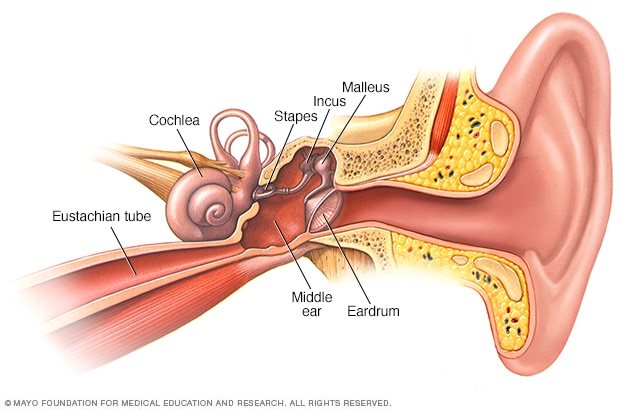Overview
A ruptured eardrum (tympanic membrane perforation) is a hole or tear in the thin tissue that separates the ear canal from the middle ear (eardrum).
A ruptured eardrum can result in hearing loss. It can also make the middle ear vulnerable to infections.
A ruptured eardrum usually heals within a few weeks without treatment. But sometimes it requires a patch or surgical repair to heal.

Ruptured eardrum
A ruptured (perforated) eardrum prevents the proper transmission of sound waves to the middle ear and leaves the middle ear vulnerable to infectious agents, water and other foreign substances.
Symptoms
Signs and symptoms of a ruptured eardrum may include:
- Ear pain that may subside quickly
- Mucuslike, pus-filled or bloody drainage from the ear
- Hearing loss
- Ringing in the ear (tinnitus)
- Spinning sensation (vertigo)
- Nausea or vomiting that can result from vertigo
When to see a doctor
Call your health care provider if you have signs or symptoms of a ruptured eardrum. The middle and inner ears are made up of delicate structures that are sensitive to injury or disease. It is important to try to figure out the cause of ear symptoms and determine whether a ruptured eardrum has occurred.
From Mayo Clinic to your inbox
Causes
Causes of a ruptured (perforated) eardrum may include:
- Middle ear infection (otitis media). A middle ear infection often results in the accumulation of fluids in the middle ear. Pressure from these fluids can cause the eardrum to rupture.
-
Barotrauma. Barotrauma is stress exerted on the eardrum when the air pressure in the middle ear and the air pressure in the environment are out of balance. If the pressure is severe, the eardrum can rupture. Barotrauma is most often caused by air pressure changes associated with air travel.
Other events that can cause sudden changes in pressure — and possibly a ruptured eardrum — include scuba diving and a direct blow to the ear, such as the impact of an automobile air bag.
- Loud sounds or blasts (acoustic trauma). A loud sound or blast, as from an explosion or gunshot — essentially an overpowering sound wave — can rarely cause a tear in the eardrum.
- Foreign objects in your ear. Small objects, such as a cotton swab or hairpin, can puncture or tear the eardrum.
- Severe head trauma. Severe injury, such as a skull base fracture, may cause the dislocation of or damage to middle and inner ear structures, including the eardrum.

Middle ear
The middle ear has three small bones — the hammer, or malleus; the anvil, or incus; and the stirrup, or stapes. The eardrum keeps the bones away from the outer ear. A narrow path called the eustachian tube joins the middle ear to the back of the nose and upper part of the throat. The cochlea, a snail-shaped structure, is part of your inner ear.
Complications
The eardrum (tympanic membrane) has two primary roles:
- Hearing. When sound waves strike it, the eardrum vibrates — the first step by which structures of the middle and inner ears translate sound waves into nerve impulses.
- Protection. The eardrum also acts as a barrier, protecting the middle ear from water, bacteria and other foreign substances.
If the eardrum ruptures, uncommon problems can occur, especially if it fails to self-heal after three to six months. Possible complications include:
- Hearing loss. Usually, hearing loss is temporary, lasting only until the tear or hole in the eardrum has healed. The size and location of the tear can affect the degree of hearing loss.
- Middle ear infection (otitis media). A ruptured (perforated) eardrum can allow bacteria to enter the ear. If a perforated eardrum doesn't heal, a small number of people may be vulnerable to ongoing (recurrent or chronic) infections. In this small group, chronic drainage and hearing loss can occur.
Middle ear cyst (cholesteatoma). Although very rare, this cyst, which is composed of skin cells and other debris, can develop in the middle ear as a long-term result of eardrum rupture.
Ear canal debris normally travels to the outer ear with the help of ear-protecting earwax. If the eardrum is ruptured, the skin debris can pass into the middle ear and form a cyst.
A cyst in the middle ear provides a friendly environment for bacteria and contains proteins that can damage the bones of the middle ear.
Prevention
Follow these tips to avoid a ruptured (perforated) eardrum:
- Get treatment for middle ear infections. Be aware of the signs and symptoms of middle ear infection, including earache, fever, nasal congestion and reduced hearing. Children with middle ear infections often are fussy and may refuse to eat. Seek prompt evaluation from your provider to prevent potential damage to the eardrum.
Protect your ears during flight. If possible, don't fly if you have a cold or an active allergy that causes nasal or ear congestion. During takeoffs and landings, keep ears clear with pressure-equalizing earplugs, yawning or chewing gum.
Or use the Valsalva maneuver — gently pushing air into the nose, as if blowing your nose, while pinching the nostrils and keeping the mouth closed. Don't sleep during ascents and descents.
- Keep your ears free of foreign objects. Never attempt to dig out excess or hardened earwax with items such as a cotton swab, paper clip or hairpin. These items can easily tear or puncture the eardrum. Teach your children about the damage that can be done by putting foreign objects in their ears.
- Guard against explosive noise. Avoid activities that expose the ears to explosions. If your hobbies or work involves planned activities that produce explosive noise, protect your ears from unnecessary damage by wearing protective earplugs or earmuffs.